The Beautiful Game of Volleyball Serves up Many of Life’s Lessons
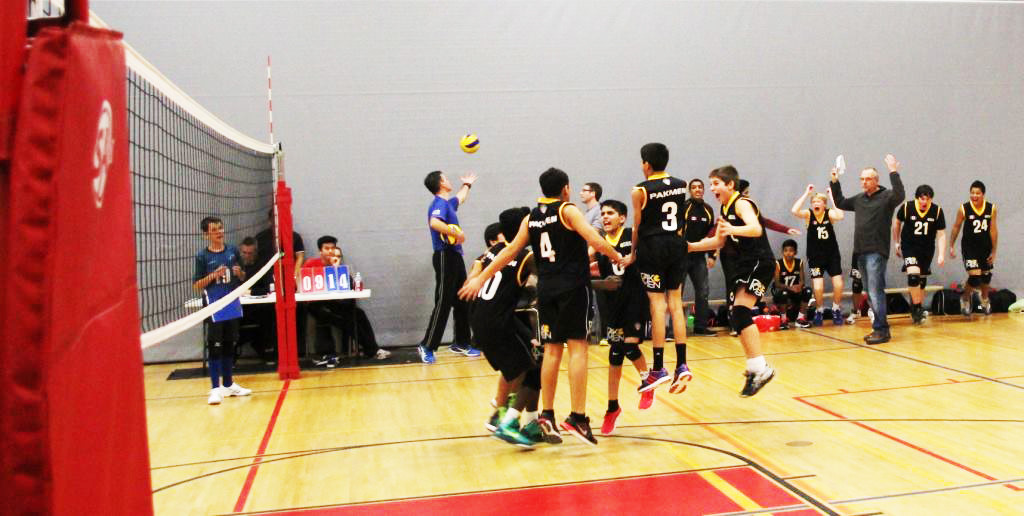
For years, many Canadians have looked upon volleyball as a peripheral sport for the “not quite gifted enough,” or the “play it safe” athlete.
Not good enough to excel in basketball. Not macho, or aggressive enough, to make it in hockey, or football.
But peoples’ perceptions are changing. It won’t all happen overnight, but gradually, more and more Canadians are appreciating the athleticism, focus and co-ordination volleyball demands of its top athletes.
To delve deeper into the many positives volleyball can offer the young athlete, we summoned the knowledge of some of this continent’s volleyball stars, including players, coaches and executives.
This is what they had to say.
The beautiful game of volleyball serves up many of life’s lessons.
By DAVID WINER
Volleyball is the Rodney Dangerfield of sports.
An accurate depiction, if you believe the man who coined the phrase, “I tell ya, I get no respect – no respect at all,” actually didn’t receive much adulation in life.
Born in 1921, Dangerfield struggled, even working as an aluminum siding salesman, until he made it big on the Johnny Carson show. By the end of his career Dangerfield had fame and fortune and was adored by millions of fans worldwide who still rate Caddyshack as one of their all-time favorite movies.
Very much like Dangerfield, volleyball, on the surface, may seem disrespected by North Americans addicted to the NBA, MLB, NHL and NFL. But peel back the layers, and the statistics tell a very different tale.
For instance while viewership remains low, Canadians participating in volleyball remain in the upper echelon of sports.
According to a 2005 study by Statistics Canada, volleyball has the seventh highest participation rate, trailing golf and hockey, bunched neck-and-neck with swimming, soccer, basketball and baseball, and well ahead of skiing, cycling and tennis.
Volleyball also has the sixth highest percentage of participants in organized sports for 5-14 year-olds.
Closer to home, in the Region of Peel, volleyball has actually eclipsed basketball, despite the presence of the popular Toronto Raptors NBA franchise in its backyard.
“Volleyball is in an interesting space in the sports world,” says John Uren, Resource Teacher: Extra-Curricular Athletics. “As someone who organizes many events for the Peel District School Board (second largest in the Ontario) I get to see the level and participation of all our sports first hand. In our Elementary schools, volleyball is at the same level of popularity as basketball. Almost every school in our system has four teams that they enter into events, which is very similar to basketball.
“What is more surprising (to some) is when we move to Secondary schools, (where) volleyball becomes the most popular sport based on the number of school teams entered in our leagues year-to-year.”
According to the 2013-14 statistics, the biggest discrepancy was in junior and senior girls play. While the numbers were nearly even with boys in both sports, there were six more senior girls teams in volleyball as opposed to basketball, and a whopping 12 more squads in junior play.
And in the United States, volleyball for girls surpassed basketball this past season to become the No. 1 team sport, behind only track and field, in total participatory numbers.
So why is volleyball so successful among participants, but not among fans?
Well, other than every four years when the Summer Olympics excite billions of viewers worldwide, the indoor and beach varieties of the sport rarely get exposure on television.
It also doesn’t help that the lone medal won by Canada was at the 1996 Atlanta Olympics, when Mark Heese and John Child celebrated with bronze medals on the beach.
There certainly appears to be no role models to aspire to. No Wayne Gretzkys, Silken Laumanns, Donovan Baileys, Alex Baumanns, Kurt Brownings. No Ferguson Jenkins, Russ Jacksons, Nancy Greenes, Steve Nashes, Clara Hughes’ and Catrina LeMay Doans.
In fact, of the 602 members in the Canadian Sports Hall of Fame, there isn’t a single volleyball player. Not one.
There are 118 hockey players, 54 football players, 41 rowers, 41 in athletics, 27 figure skaters, 23 swimmers, 17 golfers, 14 curlers and 14 speed skaters. Heck, this country has inducted a skeet shooter, a snooker player, even a pistol shooter into its Hall of Fame, yet no volleyball player.
It’s therefore no wonder many Canadians envision carefree vacationers slapping a beach ball over a net, or perhaps youngsters trying to learn the rules during Grade 5 gym class, when queried about volleyball.
For the majority of Canadians, there’s the impression volleyball finishes the day high school ends.
That’s far from true. A number of Canadians are playing key roles for highly ranked NCAA colleges this year.
And for the multi-talented, there is the chance of turning professional abroad.
Cast your eyes across the Atlantic and Pacific Oceans, and volleyball players are mega stars. Over 900 million fans across Asia, Europe, Australia and the Americas, make volleyball the sixth most popular sport in the world, behind soccer (3.5 billion fans), basketball and cricket (2 billion viewers), field hockey and tennis.
Because youngsters on those continents grow up with the sport, understanding the nuances and intricacies of volleyball and envision a future where they can one day become an Olympic hero, or a professional star like their idols who can demand six, and at times, seven-figure contracts.
So why do youngsters and adults throughout much of the world value volleyball so highly?
And why should parents here in Canada give volleyball more consideration when deliberating over what sport to introduce their child to?
Some of this continent’s most prominent players, coaches and administrators were posed this very question.
What makes volleyball so special?
Sarah Pavan, arguably this country’s top professional player, was sought out, as was men’s National Team head coach Glenn Hoag.
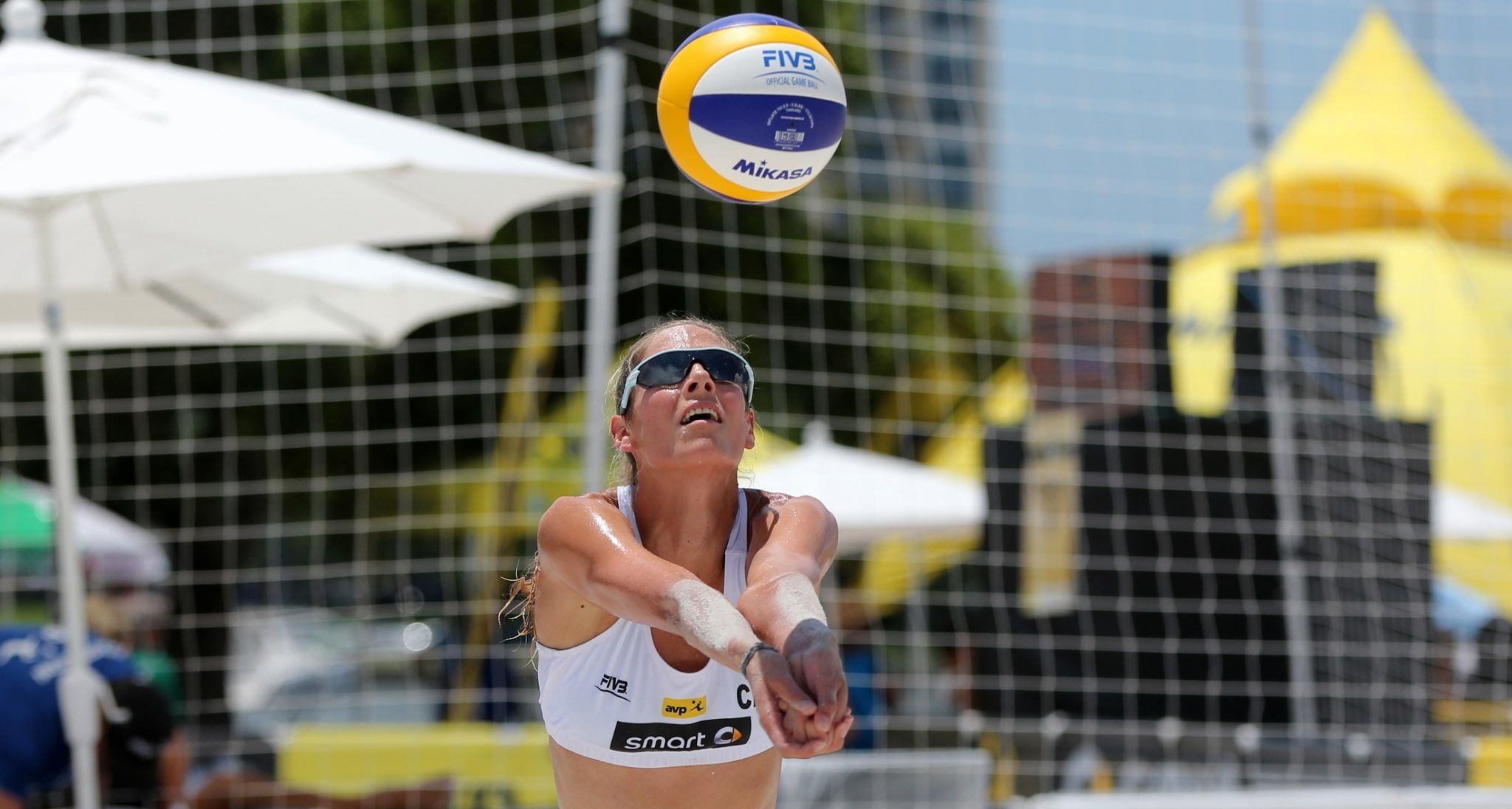
Professional Volleyball player Sarah Pavan in action.
On the administrative side, long-time University of Toronto head coach and current Pakmen Volleyball club mentor Orest Stanko, lent his voice, as did Kristine Drakich, a former beach volleyball star and current coach of the powerful U of T women’s program.
To add more of an international flavor to the discussion, American Volleyball Coaches Association Hall of Fame member John Kessel was asked to point out the great positives and strengths of the sport and how it prepares youngsters for the future, both mentally and physically.
Together, they are involved in every aspect of the sport, from playing indoor and beach volleyball at its highest levels, to coaching, both young and old, amateurs and professionals.
And together, they have one thing in common; a passion and love for a sport that is sometimes short-changed by the uninformed and uninitiated, as well as those who enjoy the sport once every four years.
“I do think that volleyball is a great participation sport and is continuing to grow,” says Drakich. “Cities like Toronto are great for volleyball because of the collection of people from countries where volleyball is so popular – (this past summer’s) Pan Am Games beach and indoor events demonstrated this. The venues were sold out each night with incredibly passionate fans – it was awesome to experience and for many who play the sport, to see that excitement….if only we could feel that more often. But we just don’t have that many volleyball events to build on each year. It would be nice to see volleyball, at any level, in the media more often.”
Hoag, who has a better grasp on the international scene than most, explains some of the hurdles.
“In Europe volleyball is part of the club mentality of classic Olympic sports like handball, basketball, track and field. Those base sports have always been traditionally strong. Here, culturally, strong sports like American football, baseball, basketball and ice hockey have this traditional approach.”
And Hoag adds, “There would be a need for a pro league,” for the priorities among North American fans to change, “because the college seasons are too short and hard to promote.”
While Hoag feeds his love for the sport by escaping to Europe, where he calls it, “the Mecca of volleyball internationally,” for part of the year, Stanko applies his trade in Mississauga year-round as the head of the much heralded Pakmen Volleyball Club.
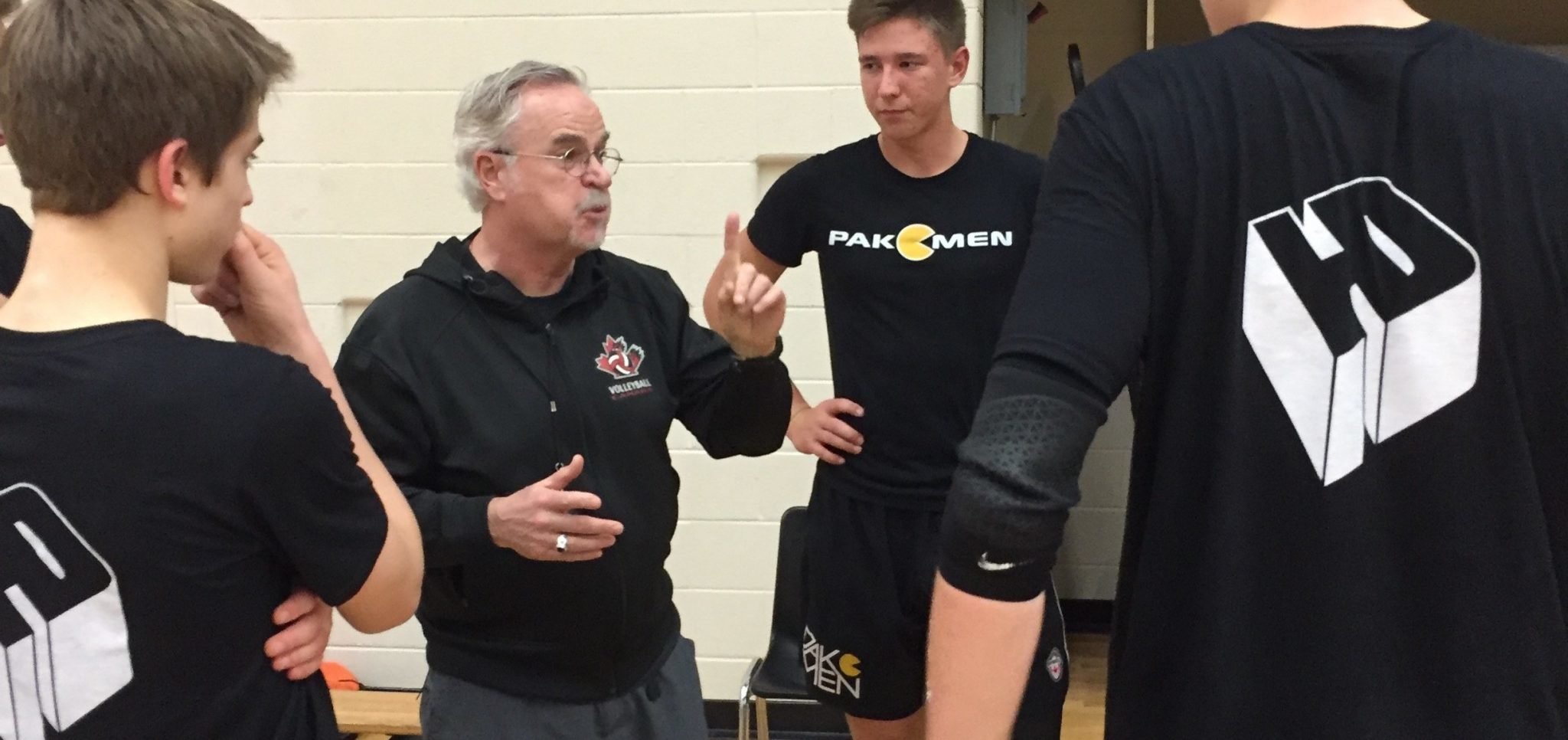
Long-time University of Toronto head coach and current Pakmen Volleyball club Head Coach Orest Stanko.
“As far as volleyball is concerned, it is baffling and at the same time frustrating that a sport that is played by hundreds of thousands of Canadians has not catapulted into the mainstream of North American sports,” he said.
“The majority of North Americans have a very insular preoccupation when it comes to sport,” continued Stanko. “How else do you explain the almost clinical withdrawal symptoms that many suffer following the Super Bowl in anticipation of the next NFL season. We need not even mention hockey in Canada.”
Stanko is referring to what Canadians, and North Americans in general, don’t realize. That volleyball has a far different appeal in many other parts of the world. From South America to Europe, and from Asia to Russia, professional volleyball is followed by the mainstream media and by the millions of fans who pack the arenas and beaches with the same frenzied passion reserved for hockey in Canada.
“Having lived in countries where volleyball is viewed as a top-two sport (behind soccer), living in Canada, where it is not appreciated by the average sports fan, is definitely frustrating” admits Pavan. “I would love to be able to make the kind of living I do playing in a league in North America, but unfortunately, volleyball isn’t as embedded in our culture as it is in Europe, or South America, or Asia. The average North American hasn’t been exposed to enough volleyball to fully understand the game, which makes it tough for the sport to make a break-through into mainstream culture. But I hope one day it will.”
So, the Kitchener native continues to establish a following abroad having starred for indoor club teams in Italy, Brazil and Korea. This winter, when the FIVB (International Volleyball Federation) beach circuit concludes, Pavan will suit up for a team in Shanghai, China.
And at each stop in her career, Pavan has been a recognizable figure on the streets and in the airports with adoring fans hoping to snap a photo or garner an autograph from the 6-foot-5 star, who broke in with Canada’s senior national team as a 16-year-old, was named the top female collegiate athlete in the United States in any sport, and after shifting to the beach scene in 2013, is practically a shoo-in to represent Canada at the 2016 Olympics in Rio.
Pavan and partner Heather Bansley comprise Canada’s top beach volleyball team. In this calendar year, the pair has earned two silver and two bronze medals on the FIVB World Tour. They are currently ranked fourth in the world behind two powerhouse Brazilian teams and a duo from Germany in the Provisional Olympic Rankings.
“Over there, people live and breathe your sport,” says Pavan, much like in North America with baseball, football, hockey and basketball.
Pavan was asked if North American sports gained popularity among broadcasters and viewers because of the star element and a degree of bravado among certain players who pound their chests and pump their fists after a big tackle, a strikeout, or a massive dunk.
“I don’t think North American media focuses on the mainstream sports because of ego and greed. In my opinion, those sports are in the spotlight because they are historically part of North American culture,” said Pavan. “The average North American understands the ins and outs of those games well, and most of them are timed games, which are much easier to broadcast on TV. Everyone likes to talk about an in-your-face athlete for the entertainment factor, but I don’t think that makes mainstream sports any less team-oriented than volleyball. If the athletes in those sports didn’t know how to work together, they wouldn’t be successful. There are many volleyball players that are egotistical and greedy too. It is not unique to popular North American sports.”
ULTIMATE TEAM SPORT
Having said that, Pavan wholeheartedly believes volleyball is the ultimate team sport.
“One of the things I love about volleyball is that one player alone cannot dominate a game. One player can only have a maximum of two out of the three contacts on a side, which does lead to a sort of dependency on one’s teammates. This is especially evident in kids’ sports, where one kid will dribble the basketball from end-to-end and score, or in hockey where the same things will happen. While volleyball may be more frustrating for talented kids early on, who must rely on perhaps less-talented teammates to succeed, as athletes improve and mature, it really is a beautiful game. Volleyball is a technically difficult sport for people who are just starting out, but at the high levels, I cannot undervalue what hockey or basketball or baseball players are able to do physically. At the top echelons of any sport, the athletes are all extremely talented.”
Stanko concurs.
“Consider the uniqueness of volleyball as a team sport,” he said. “In many other team sports you are able to achieve success without the support of a teammate. In soccer you can dribble up the field and score without having to rely on a teammate; similarly in basketball. In baseball you can come to the plate and belt a home run…no teammate necessary to serve up the ball. In many respects volleyball does represent the quintessential team sport that is inextricably dependent on a precisely choreographed sequence of events and the establishment of a harmonious environment; and this goes beyond merely the starting six players.”
Even former Prime Minister Stephen Harper appreciates and applauds the team concept required.
“Volleyball has been a big part of the Harper family as both of our kids, Ben and Rachel, have taken up the sport,” said Harper. “As Prime Minister, you have to make the most of the time you spend with your kids. Laureen and I have enjoyed watching Ben grow up playing volleyball and have managed to watch a few of his games with the Queen’s University Gaels where he attends on a volleyball scholarship. We also went home to Calgary earlier this year to watch Rachel play in the Volleyball Canada tournament.
“Whether pick up games in the community, or organized competitive leagues, volleyball is a great team sport to watch, play, coach or referee. I salute Volleyball Canada for making volleyball part of Canada¹s communities.”
As Kessel suggests, you will be hard-pressed to come up with another sport where players are so reliant on one another.
“The dependency players have on one another for setting, blocking, saving shots. The teamwork, camaraderie required, in tandem with coordination, focus, anticipation, physical stamina, need for jumping, sprawling, etc.? I love;
- Jumping as high as I can, and while up there, hitting the ball as hard as I can;
- Blocking a player’s hardest hit;
- Digging a player one armed and up to keep the rally alive;
- Serving aces – bullets that fly over as knuckleballs and get shanked;
- Celebrating every good play, and regrouping when it does not go our way, supporting the player who erred and;
- I love the very important concept of bettering the ball.”
A LESSON LEARNED
Not to mention, bettering a person.
“Like all team sports, volleyball definitely helps in the development of critical life skills that I feel go a long way to creating a well-rounded individual,” says Pavan
“For children, who may lack confidence or feel like they don’t fit in, being part of a team can help instill a sense of belonging and of being an important part of something bigger than themselves. Playing a team sport helps children learn discipline and accountability, and especially today, it teaches the skills of prioritization and commitment. Good leadership skills can be found in children who have participated in team sports, and something that I emphasize in my own life, which I learned very young, was the skill of goal setting. Even if kids don’t go on to be professional athletes, these skills are invaluable in the classroom, and later in life, in the workplace.”
U of T women’s head coach Drakich is a prime example of some of the lessons learned playing the sport.
Past President of the Ontario Volleyball Association, president of the Canadian’s Women’s Volleyball Coaches Association, a spokesperson for the Breast Cancer Society of Canada, involved in the Osteoporosis Society fundraising walk, the sport has been very important in shaping Drakich’s life.
“Sport in general can help people to prepare for life,” says Drakich, “from learning to be disciplined; to developing an unconditional work ethic; to working with others toward a common goal; managing relationships; to being resilient and rising to challenges; to getting outside one’s comfort zone; to problem-solving, etc. Volleyball can be very great at doing this because of the interconnected nature of the sport – no one player can control the ball, there is always a reliance on others and because the space the team works together in is very small.
“I think it’s a great sport – it requires all types of movements, power and finesse, good eye hand coordination, awareness and communication,” continued Drakich, who has volunteered at every level of the sport from the FIVB World Council of Beach Volleyball level down to the grassroots. “It’s also played in such a small space that all teammates are close to one another and the transition from offense to defense is constant and sometimes unpredictable so movements and skills need to be very well coordinated.”
SINGING KUMBAYA
Listening long enough to Kessel, one’s left to believe volleyball may be a better solution to discourse than seeking a counselor’s or psychiatrist’s advice.
“Prisons have volleyball often,” Kessel explains, “as it helps the inmates get along. There are no fouls (imagine if there were…), nor penalty boxes, or penalties for unnecessary roughness. You get stuff blocked and you can’t take it out on your teammates, you have to control your emotions in a new way.”
Kessel, who was named one of the 50 most important people in the sport of volleyball in the first 100 years by Volleyball magazine, goes on to add that cupid’s been known to hang around the court.
“Volleyball is a fantastic co-ed sport,” he explains, “and tens of thousands of marriages have happened from co-ed team play, with partners found on opposing teams and your own team.”
For a prime example one needn’t look any further than the Brampton Volleyball League Players’ Forum, where the Blizzards’ team posted a message seeking players.
“We are looking for both a female and male player to join our team,” read the message for the Intermediate co-ed non-spiking team. “So if you’re a couple looking for a team, let me know. Nothing keeps you together with your mate more than friendly competition. We will take single players as well, so please let me know if you’re interested. ”
Having to play in such small quarters in volleyball, harmony is essential.
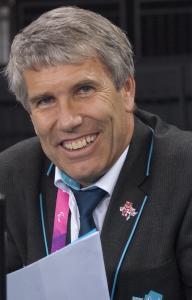
American Volleyball Coaches Association Hall of Fame member John Kessel.
“Our sport is the most crowded,” says Kessel. “Twelve people on 9×18-metre (playing surface). But we have to get along. You have to read the other side of the net…and once good at volleyball, you can do other sports where you get to hold onto the ball. You learn about your body in special ways, as you must rebound off of it, and play just off the floor then jump up and hit high off the floor. Over and over and over. And the bench is its own cheer squad, but that is common in sport.”
And that need for perfect harmony becomes increasingly essential the more talented the player becomes.
“Volleyball is very unique because the athlete has to learn many different skills in order to perform and then each individual skills will have to be synced with other athletes’ actions in order to have harmonized execution,” says Hoag. “It is very unique. (Skill wise) It is a mix of rebound sports like tennis or badminton and I would compare it to rugby or football tactically where you have to create openings in the opponent’s defense to score points or close gaps to prevent the opponent to score. And all this in the matter of a few seconds….what a great and challenging sport!”
NEVER SAYING NEVER
“I love the idea of relentless pursuit,” says Kessel, who serves as secretary of the NORCECA (North, Central America and Caribbean Volleyball Confederation) Technical & Coaches Commission, and is an FIVB Level IV clinician. “For once the ball is struck on service, your court size, should a teammate have erred, is half the world if you could run that far. Walls and court barriers get in the way, but the court starts 9x18m than gets huge. We don’t dance down a line, or give up when it goes three feet out. We pursue. Great lessons there too.
“I love that we are the only ones who know where the lost prom balloons and badminton birdies are. I love the range of play of our sport. In a single rally it goes from a pancake save one inch off the floor to sets as high as 10 metres in the air; and players hitting at 12 inches or more above the net every third hit; and I love that we have only three hits till we must get it to go over, so you can’t back out or run a new way, you have to solve it right then and there.”
Such demands on a player often demands special talents.
JACK (AND JILL) OF ALL TRADES
It’s the old cart before the horse, chicken or the egg argument.
Volleyball players tend to be superior athletes capable of playing a number of sports well. So, either athletes are drawn to volleyball, or volleyball produces superior athletes.
Kessel, whose passion for volleyball has made him one of the most highly regarded international instructors in the world, conducting seminars in all 50 states and over 50 countries, points to American Karch Kiraly as an example.
“The first thing I thought is that Karch Kiraly, now (the US women’s) head coach after (winning) three golds (both indoor and beach as a player) and being named best volleyball player in the sport’s first 100 years by the FIVB, and how he almost won the (TV-produced) SuperStars competition back 30 years ago (against athletes from a cross-section of sports). Volleyball players are great all around athletes. Heck, (my children) Cody (now playing professionally after starring at Princeton) and Mac played 10 sports each growing up.”
Closer to home, Hoag, Pavan and Drakich were each multi-sport stars before eventually turning to volleyball full-time.
“I started (volleyball) in high school at the age of 16,” recalls Hoag. “My parents didn’t want me to play hockey anymore and focus on my school. So, being crazy about sport, I did track, basketball and volleyball. Volleyball became a real passion. I enjoyed it more than the other sports so I naturally moved to the sport.
“(While) I was a decent hockey player, (and) I did well in track and field in long jump and triple jump, what made me stick to volleyball, was the technical complexity, the speed at which things happened.”
Drakich, who has led the Blues to seven Ontario championships since joining the program in 1989-90, also required time to choose a favorite sport.
“Although I was familiar with volleyball since we grew up around it – my mother, Mary, played volleyball and was a member of Canada’s national women’s team in the late 1960’s and my dad, Eli, enjoyed playing and coaching as well – I didn’t begin playing it in school until Grade 8 and I didn’t begin to play club until Grade 11. I played many different sports, but not volleyball, so I do think I was trying to find another passion, but in the end, volleyball won out.”
Drakich insists trying one’s hand at a variety of sports before specializing in one, is essential.
She emphasizes that it is crucial for children to sample many activities while growing and developing.
YEAR-ROUND SPORT
“It’s great to be able to play the sport year-round as long as it is not the only sport one plays as they are growing up. Playing many sports at a young age is a great way to develop foundational athletic skills.
“I loved both indoor and beach, but the beach was so easy to play with friends, and it was great to learn the game without coach intervention during the game. It’s hard to play pick-up volleyball but beach/doubles is one way to do that.”
A SPORT FOR THE AGES
While Pavan is in her prime, she looks forward to playing volleyball well after her career is over.
And with a 75-and-over division at the Canadian Masters championships, that should be for a long, long time.
In the much more highly populated United States, the US Open actually has a 79-and-over age category for men.
“Volleyball is special because it is a sport that people of any age or skill-level can play,” she says. “Because of its low-impact nature, people can play it for their whole lives, and because it is conducive to social settings, people of any skill-level have been able to find their niche within the sport. It is a sport that promotes great hand-eye coordination in children, and due to its rare format of constantly starting and stopping, volleyball allows teammates to celebrate each other’s successes and offer a helping hand when it is necessary. It is a great team game.”
ALWAYS ‘ABLE’ AND READY
With Kessel’s tireless help as the Director of Development on the World ParaVolley board, volleyball has become an ever expanding team game.
Introduced at the Toronto Paralympic Games in 1976, sitting volleyball has become a medal sport ever since. Open to amputees, as well as people with spinal cord injuries, cerebral palsy, brain injuries and strokes, players compete in a seated position on either side of a lowered net.
“We see sitting as simply a discipline of volleyball, like beach,” said Kessel, who explains that in the Netherlands there are 4,000 members in the sitting program, even though they include 3,500 able bodied athletes, “who just like to play this version, with their 500 disabled volleyball friends.”
And the sport continues to grow.
“Prince Harry (hosts) the Invictus Games where wounded warriors play from all over the world,” said Kessel. “It will be in Florida next summer, and we in the USA have had Warrior Games for seven years now for the injured vets.”
Closer to home, the Canadian women have become this country’s first team to qualify for the Rio 2016 Paralympics.
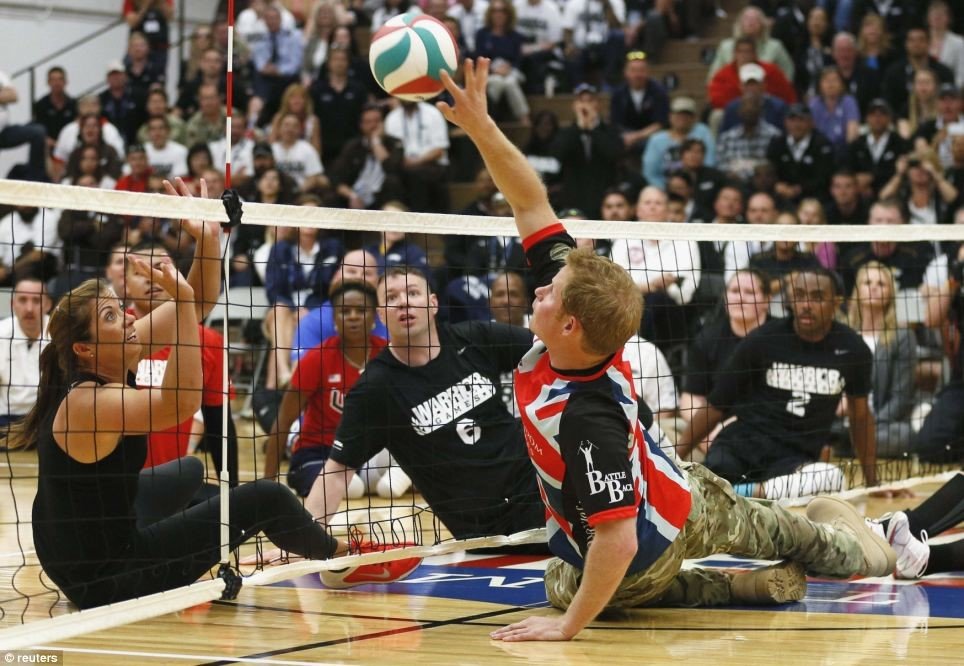
Prince Harry vs. Olympian Misty May-Treanor, 3-time Olympic gold medalist.
SAFETY EVEN IN NUMBERS
Then there’s the safety aspect.
As in any sport, injuries are bound to crop up when play becomes intense, but the mere fact a point can’t be decided by physical contact with the opposition, separates volleyball from football, rugby, even basketball and baseball.
“With volleyball, you cannot prevent your opponents from playing by physical contact,” says Hoag. “So you cannot hold, push, or physically disengage the player.
“It’s all about how well you can execute. We know who failed or did well with every contact and that is why I think volleyball athletes are pretty special. They need to improve the skills to contribute to the team success. In return there will be moments when the teammates will have to fix an error by one of their teammates. This sport teaches patience and develops tenacity if an athlete wants to have fun playing it (meaning being better technically).”
However, as in any sport, injuries can occur. Drakich is a prime example. Playing alongside partner Erminia Russo in the $500,000 Nokia Open Tournament in 2000, Drakich collided with Russo in mid-air suffering temporary paralysis. It was later determined Drakich had suffered brain and spinal concussions.
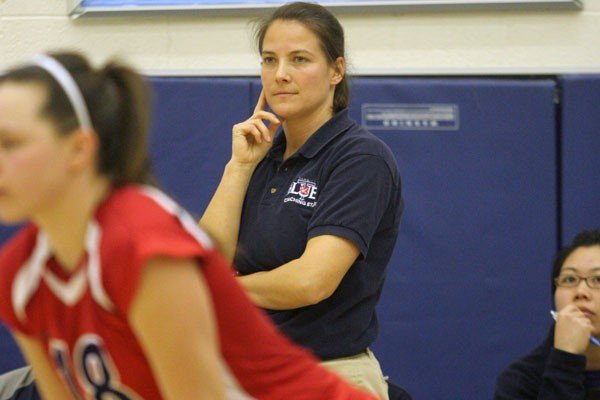
Kristine Drakich Head Coach of the U of T women’s Volleyball Program.
“What happened with Erminia and I was a rare event. Having said that, every sport played at a high level has risk – both chronic/long-term and acute injuries. I think team sports are always at a bit higher risk and in volleyball there is the coordination of the player movements in a small space,
accelerations/change of directions and unpredictable ball movements that do make the risk of injury moderate, with indoor volleyball having more risk than beach.”
Rare, is certainly the key word here
“It is far safer than all the other major sports,” stresses Kessel. “Our IMPACT manual, a book I first wrote in 1988, and is updated annually, shows that data. We simply are not a contact sport.”
COMES IN ALL SHAPES AND SIZES
Another major positive with volleyball is that it is chock-full of both tall and petite stars.
There’s no shortage of giants in the sport whose spikes are so violent, the ball hurtles straight down at 130 kilometres an hour.
Bulgaria’s Matey Kaziyski reached a speed of 132 kph on one of his spikes. But Canada’s 6-foot-10 behemoth Gavin Schmitt doesn’t take a back seat to anybody. A top indoor player in Turkey for a number of years, he’s been named most valuable player, top scorer, best spiker and best server.
However, as everyone has discovered, whatever goes up, must come down.
And some of the sport’s best setters and diggers can be mistaken for jockeys.
Volleyball players, “come in any size,” says Kessel, “as it is not how tall you are, it is how good you are. Japan’s bronze medal setter from 2012 London (Olympics)? Five-feet-two.”
Listed at 5-foot-3, Yoshie Takeshita represented Japan in the 2004, 2008 and 2012 Olympics and is considered the world’s smallest and strongest setter. Yet, she was only one of three 5-foot-3 players on the bronze medal winning team, along with Hitomi Nakamichi and Yuko Sano.
Japan doesn’t have a monopoly on diminutive, yet dynamic, volleyball players.
South Korea’s Hyun-Jung Na, the Dominican Republic’s Brenda Castillo, Japan’s Kotoki Zayasu and Mio Sato, Canada’s Janie Guimond and Great Britain’s Joanne Morgan, all have more than starring for their respective National teams in common. They all stand 5-foot-6, or under. Sato, actually, measures in at 5-foot.
One of the greatest players to come out of the United States is Debbie Green Vargas. A member of the National team for 12 years, she was only 5-foot-4.
“What I gave up in height, I tried to make up by being able to set almost any pass and by giving to my volleyball team in other ways, like enthusiasm, energy and talk.
“My goal was to be the best volleyball setter there was, short, or tall.”
“I wanted to prove that 5-4 wasn’t too short to play volleyball even though I’d get asked frequently if I was the manager of the volleyball team.”
With special strengths and requirements needed for each and every position on the floor, whether it be outside hitter, setter, middle blocker, opposite hitter, or libero, there is a time and place for players of all shapes and sizes.
BE A ‘ROAD’ SCHOLAR
Opportunities for a continued education while prolonging and bettering your volleyball skills have never been better.
“Over the course of the last few years Canadian universities and colleges have started to offer scholarship incentives, which are usually tied to academic performance,” said Stanko, adding, “I would recommend that everyone who elects to play volleyball also ensure that they acquire a good education and marketable degree.”
If there’s a desire to attend a high-profile school in the United States, the doors are always open to Canadians who have the talent coupled with the marks.
Pavan is just one of the many Canadians who have starred for NCAA schools in the United States for decades. Pavan just happened to prevail at everything she put her mind to, including a perfect 4.0 grade point average while graduating with a degree in Biochemistry.
“Since volleyball isn’t one of the top North American sports, I have found that a lot of people really have no clue what doors can open because of volleyball,” says Pavan. “To start, there are regional and provincial teams for kids to represent their province, and there are Youth and Junior National Team programs that allow kids to represent their country while seeing a little bit of the world. American universities (some Canadian universities are getting on board) offer full-ride scholarships for volleyball players, leaving parents or students with absolutely no university-related expenses. Senior national team programs allow athletes to compete at the University Games or Pan American Games, Grand Prix/World League, and the Olympic Games.”
A small sampling of Canadians plying their talents in the US this year for highly ranked schools, include Tori Gorrell at Penn State, Tami Alade at Stanford, Natasha Burns and Emily Maglio at Hawaii, Alicia Ogoms at USC, Alexandra Poletto at Colorado State, Alex Gray at BYU, Sara Kovac at Loyola Marymount, Emily Ruetter at Ohio State, Alyssah Fitterer and Autumn Bailey at Michigan State and Whitney Follette at Arizona State.
“Going to (University of) Nebraska on a scholarship was one of the best decisions I have made in my life,” says Pavan. “I loved my time there, I grew a lot as a person, and I wouldn’t change that decision for anything. I am a huge proponent for kids going to the States on scholarship. Academics were always my priority, and being able to get a reputable degree from a good school for nothing seemed like a no-brainer. Also, athletically, the level of competition is much higher than what we see in Canada. So if playing at a high level or continuing to play after school are goals, there is nothing that can better prepare someone for that. I wish more kids went south to experience that. It is definitely a sacrifice, moving so far from home at such a young age, but in my opinion it is worth it.”
SEE THE SIGHTS
Those fortunate and talented enough can extend their careers overseas once their post-secondary education is completed.
Hoag, who has coached Canada’s men’s National team since 2006, keeps busy year-round by heading up Turkey’s renowned Arkas Sports Club in the picturesque Aegean port city of Izmir eight months of the year.
“The structure of the club where I am working is one of the best I have ever worked with as a professional club,” said Hoag. “Our main financial supporter is the Arkas family. They own container (ships). They fell in love with the sport years ago and they built a structure with two gyms, a weight room and a medical center. I coach the senior team, but I am also hired as technical director. We have 700 kids, both boys and girls at the club, and me and my coaching staff work at developing these young athletes.”
Hoag adds, “It is special to work and live there. Turkey is a very special country. The history there is really rich, they are bordered by many countries and have a completely different culture than we do.”
If Turkey is not your speed, there are a number of professional leagues to choose from, situated anywhere from China to Greece, from Iran to Italy, and from the Dominican Republic to Japan, South Korea, France, Russia and Brazil.
Currently, there are close to 40 Canadians playing abroad, the majority of which in Germany, Denmark and France.
“Countries all over the world have professional volleyball leagues, which hire foreign players to come play for them, while (usually) providing housing on top of a salary,” adds Pavan. “Top players in the world can make millions of dollars per year to play volleyball.”
Along with salaries, come the experiences and the understanding of different cultures.
“I think that as people get older, they naturally become different people,” said the 28-year-old Pavan. “I am a much different person now than when I was 22. I can say with a high degree of certainty, however, that had I not decided to play professionally overseas, and had chosen to pursue something in the biochemistry field, things would be much different.”
Having already called Italy, Brazil and South Korea home for extended periods of her career, Pavan will attempt to improve on her Chinese vocabulary while competing in Shanghai this indoor season.
“Having been immersed in cultures so different from North America for extended periods of time has given me so much appreciation for them, and it has altered how I view the world for sure,” said Pavan. “Even though I travel a lot for beach, I only ever spend one week in any given place, which makes me feel like more of a tourist than anything. It has been my experience playing indoor that has really allowed me to explore cultures and live like the locals do, which I much prefer.”
FIGHTING FOR EQUALITY
And being an accomplished star, Pavan can earn as much as her male counterparts.
For unlike most professional sports, both men and women command similar salaries, and in no small part to Drakich.
Along with everything else she has accomplished, perhaps Drakich’s greatest successes come in fighting for the equality of the sexes.
“Yes, I was very involved in fighting for equal pay and equal opportunity for women both in Canada and internationally and am very proud to say that Volleyball Canada, the Ontario Volleyball Association and the FIVB are committed to equal prize money,” says Drakich.
“It’s hard to say whether or not the women’s game is more popular than the men’s game and it depends how you measure popularity. There are more North American colleges and universities investing in women’s programs and for sure in Canada we have more females playing at younger ages than males, but I don’t know what draws more spectator interest, media coverage and sponsorship interest…check out any sport coverage and see how much of it is on women’s sport.”
AND ANOTHER REASON
Ultimate team sport, life lessons, equality among the sexes, can be played both indoors and outdoors, no age or height restrictions, creates harmony…need another reason to take up the sport?
Well, thanks to the likes of Hoag and Pavan, who have put Canada back on the international stage, this country may yet develop a number of Olympic heroes.
Since taking over the men’s program Hoag, a national team member himself from 1981-86, did a complete overhaul of the men’s program by immediately establishing a national training center in Gatineau, Que.
“When I started with the team in 2006, we reinstated the full time training center (a necessity in Canada) to bring the technical and physical potential of our athletes closer to international reality. But the important thing was to create a set of references (offensive and defensive systems) that players could relate to. Then we created a training and playing philosophy backed by performance indicators to measure the athlete and team progression. This is how we are able to stay in contact with the rest of the world.”
Hoag is being modest when he refers to Canada’s successes allowing the country, “to stay in contact.”
Having knocked off such powers as Russia on the international stage in recent years, Canada has moved up to 10th out of 160 countries in the FIVB’s latest rankings as of October, 2015.
With Brazil, Poland, Russia, Italy, USA, Argentina, Bulgaria, Iran and Germany heading the rankings, Canada is ahead of the likes of France, Serbia, Australia, Japan and China. Next, Hoag hopes to return the men’s indoor program to the Olympics, where he was a part of Canada’s best-ever finish, placing fourth in 1984.
Maybe then Canada will garner the respect, both internationally and at home with the likes of Hoag, Schmitt, Bansley and Pavan becoming household names. Who knows, maybe one, or more of them, will earn consideration for Canada’s Sports Hall of Fame.
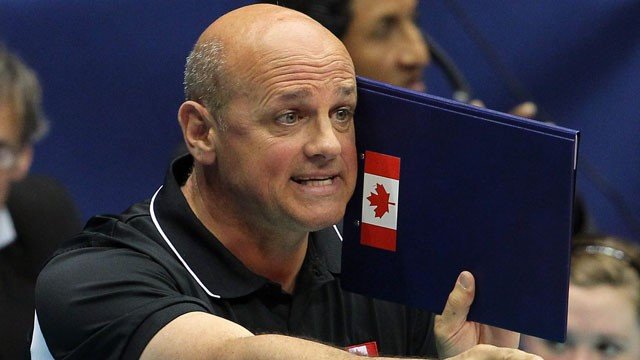
Men’s National Team Head Coach Glenn Hoag.
NEED MORE REASONS TO PLAY?
Here are 12 relevant, and perhaps irrelevant reasons to engross yourself in volleyball.
- You can play it 12 months of the year, winter, summer, spring and fall.
- You can play it indoors and outdoors. Get tired of wearing the sneaks, just kick off your shoes and go barefoot in the sand.
- Someone proficient in volleyball can become the most popular tourist during a winter escape. Once your fellow travelers and natives see your first save, or spike, they will all want you on their team.
- There are no height restrictions. Tall, or short, there is always a pivotal position on the floor for you.
- It’s a sport for all ages. In your golden years you may not be able to jump as you once could, and you may not be able to sprawl to make a save, but you will always be capable of getting the ball over the net.
- Get a free education. There are a number of free rides in the United States and some in Canada for those who are proficient in the sport and have the necessary grades.
- See the world. Whether representing Canada overseas, or competing in a foreign league, playing volleyball is a great way to travel.
- You can make a living at it year-round. Most foreign leagues play their indoor schedules in the winter, which frees up the summer for beach volleyball.
- Inexpensive. Don’t have much money to spend on a wardrobe? Shorts, T-shirt and bathing suit ought to do it.
- Diversity. Name a culture, an ethnicity, a country, hot, or cold, chances are volleyball is a popular sport.
- Beach volleyball player sounds better than beach bum when listing hobbies on your resume.
- Just the mention of volleyball is always a great excuse to head down to the beach.
Check PAKMEN’s High Performance Volleyball programs |
Check PAKMEN’s Beach Volleyball programs |
